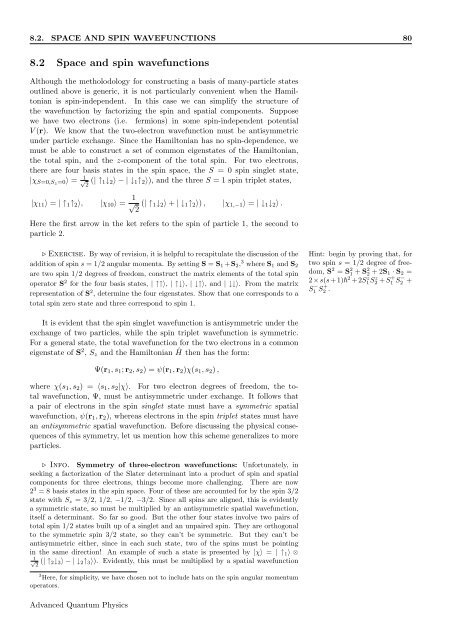Identical Particles - Theory of Condensed Matter
Identical Particles - Theory of Condensed Matter
Identical Particles - Theory of Condensed Matter
Create successful ePaper yourself
Turn your PDF publications into a flip-book with our unique Google optimized e-Paper software.
8.2. SPACE AND SPIN WAVEFUNCTIONS 80<br />
8.2 Space and spin wavefunctions<br />
Although the metholodology for constructing a basis <strong>of</strong> many-particle states<br />
outlined above is generic, it is not particularly convenient when the Hamiltonian<br />
is spin-independent. In this case we can simplify the structure <strong>of</strong><br />
the wavefunction by factorizing the spin and spatial components. Suppose<br />
we have two electrons (i.e. fermions) in some spin-independent potential<br />
V (r). We know that the two-electron wavefunction must be antisymmetric<br />
under particle exchange. Since the Hamiltonian has no spin-dependence, we<br />
must be able to construct a set <strong>of</strong> common eigenstates <strong>of</strong> the Hamiltonian,<br />
the total spin, and the z-component <strong>of</strong> the total spin. For two electrons,<br />
there are four basis states in the spin space, the S = 0 spin singlet state,<br />
|χS=0,Sz=0〉 = 1 √ (|↑1↓2〉 − | ↓1↑2〉), and the three S = 1 spin triplet states,<br />
2<br />
|χ11〉 = |↑1↑2〉, |χ10〉 = 1<br />
√ 2 (|↑1↓2〉 + |↓1↑2〉) , |χ1,−1〉 = |↓1↓2〉 .<br />
Here the first arrow in the ket refers to the spin <strong>of</strong> particle 1, the second to<br />
particle 2.<br />
⊲ Exercise. By way <strong>of</strong> revision, it is helpful to recapitulate the discussion <strong>of</strong> the Hint: begin by proving that, for<br />
addition <strong>of</strong> spin s =1/2 angular momenta. By setting S = S1 +S2, 3 where S1 and S2<br />
are two spin 1/2 degrees <strong>of</strong> freedom, construct the matrix elements <strong>of</strong> the total spin<br />
operator S 2 for the four basis states, | ↑↑〉, | ↑↓〉, | ↓↑〉, and | ↓↓〉. From the matrix<br />
representation <strong>of</strong> S 2 , determine the four eigenstates. Show that one corresponds to a<br />
total spin zero state and three correspond to spin 1.<br />
It is evident that the spin singlet wavefunction is antisymmetric under the<br />
exchange <strong>of</strong> two particles, while the spin triplet wavefunction is symmetric.<br />
For a general state, the total wavefunction for the two electrons in a common<br />
eigenstate <strong>of</strong> S 2 , Sz and the Hamiltonian ˆ H then has the form:<br />
Ψ(r1,s1; r2,s2) =ψ(r1, r2)χ(s1,s2) ,<br />
where χ(s1,s2) = 〈s1,s2|χ〉. For two electron degrees <strong>of</strong> freedom, the total<br />
wavefunction, Ψ, must be antisymmetric under exchange. It follows that<br />
a pair <strong>of</strong> electrons in the spin singlet state must have a symmetric spatial<br />
wavefunction, ψ(r1, r2), whereas electrons in the spin triplet states must have<br />
an antisymmetric spatial wavefunction. Before discussing the physical consequences<br />
<strong>of</strong> this symmetry, let us mention how this scheme generalizes to more<br />
particles.<br />
⊲ Info. Symmetry <strong>of</strong> three-electron wavefunctions: Unfortunately, in<br />
seeking a factorization <strong>of</strong> the Slater determinant into a product <strong>of</strong> spin and spatial<br />
components for three electrons, things become more challenging. There are now<br />
2 3 = 8 basis states in the spin space. Four <strong>of</strong> these are accounted for by the spin 3/2<br />
state with Sz =3/2, 1/2, −1/2, −3/2. Since all spins are aligned, this is evidently<br />
a symmetric state, so must be multiplied by an antisymmetric spatial wavefunction,<br />
itself a determinant. So far so good. But the other four states involve two pairs <strong>of</strong><br />
total spin 1/2 states built up <strong>of</strong> a singlet and an unpaired spin. They are orthogonal<br />
to the symmetric spin 3/2 state, so they can’t be symmetric. But they can’t be<br />
antisymmetric either, since in each such state, two <strong>of</strong> the spins must be pointing<br />
in the same direction! An example <strong>of</strong> such a state is presented by |χ〉 = |↑1〉 ⊗<br />
1<br />
√ 2 (|↑2↓3〉 − | ↓2↑3〉). Evidently, this must be multiplied by a spatial wavefunction<br />
3 Here, for simplicity, we have chosen not to include hats on the spin angular momentum<br />
operators.<br />
Advanced Quantum Physics<br />
two spin s =1/2 degree <strong>of</strong> freedom,<br />
S 2 = S 2 1 + S 2 2 +2S1 · S2 =<br />
2 × s(s + 1) 2 +2S z 1S z 2 + S + 1 S− 2 +<br />
S − 1 S+ 2 .

















